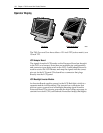
1-22 Chapter 1: 7401-2xxx and 3xxx Product Overview
• Retail Customer Information Display User’s Guide (BD20-1431-B) on
the NCR Information Products web site at:
http://www.info.ncr.com/eHome.cfm
Board BIOS
Processor boards use a Phoenix BIOS, which is stored in Flash ROM
and easily upgraded through the network connection or serial port.
The Flash EEPROM also contains the Setup utility, Power-On Self Tests
(POST), and APM 1.2 (Release 2.0-2.4) or ACPI 2.0 (Release 2.5). The
boards also supports system BIOS shadowing, permitting the BIOS to
execute from onboard write-protected DRAM.
The BIOS displays a sign-on message during POST identifying the type
of BIOS and a four-digit revision code.
FLASH memory Implementation
The Intel E28F800B5-T70 Flash component is organized onboard as
1024 k x 8 (1 MB). While a typical PC BIOS image including video and
LAN boot ROM code normally fits in 256 kB on the Pentium board and
512 kB on the Pentium III/Celeron board, the boards support a 1 MB
flash ROM. The current Phoenix BIOS release only requires 256 kB of
this 1 MB total. The Flash device contains the PC System BIOS along
with the Video BIOS and LAN boot ROM which compresses the ROM
images into a single binary image.
The Flash device is divided into four areas, as described below.
System Address FLASH Memory Area
F0000H FFFFFH 64 kB Main BIOS
EE000H EFFFFH 8 kB System BIOS Reserved during boot
ED000H EDFFFH 4 kB Plug and Play ESCD Storage Area
E0000H ECFFFH 52 kB System/VGA BIOS Reserved during boot


















